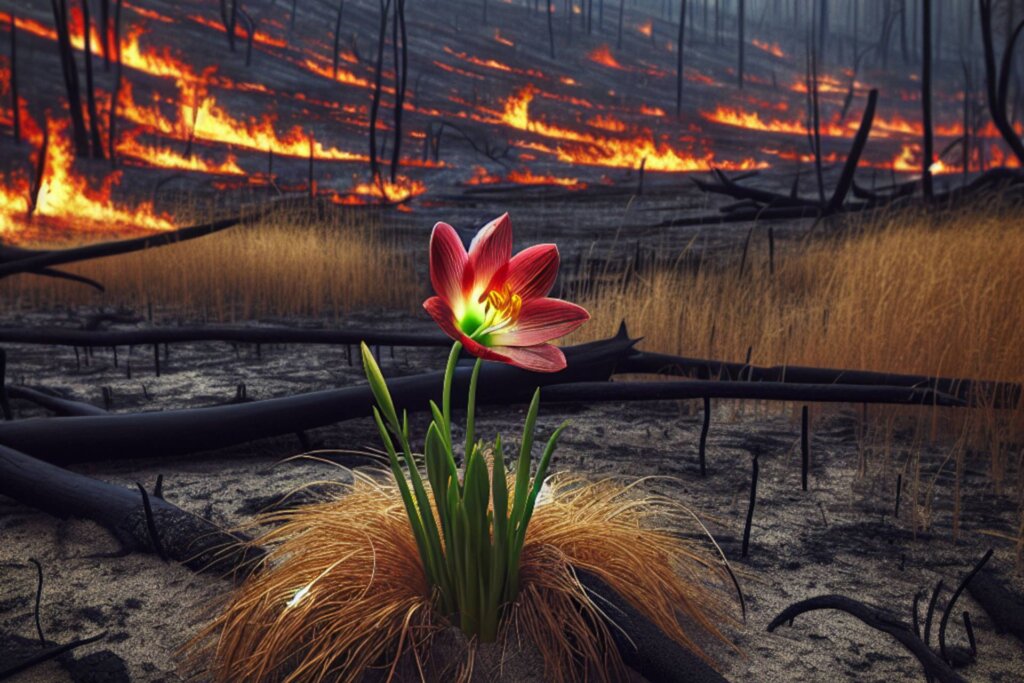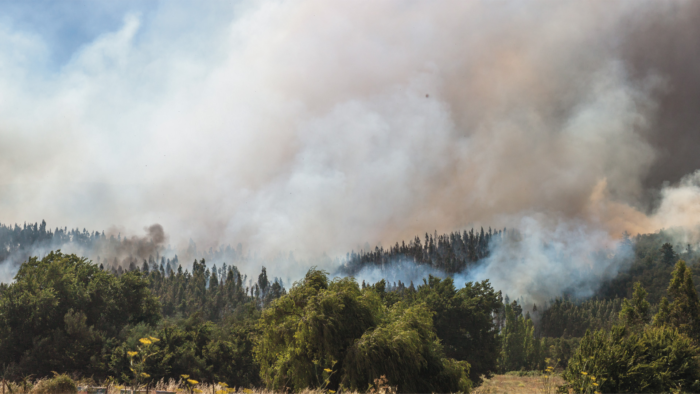The Earth’s environment is diverse, complex, fascinating, and can often be quite surprising. There’s no better example of nature’s ability to surprise us than the types of flowers that grow in burned areas after wildfires. While it may seem counterintuitive (after all, we tend to instinctively associate forest fires with the destruction of animal and plant life), some native plant species have evolved over the past hundreds and thousands of years to thrive in the very specific conditions found in the aftermath of a wildfire. These so-called fire followers can not only survive fires, they need them to germinate and maintain their place in local habitats.
To understand the relationship between fire and ecosystems, it’s important to acknowledge that while most wildfires today are caused by or related to human activity, they can be triggered by natural phenomena (such as lightning strikes) as well. This means that the risk of fire is not something new but a constant threat wildlife has always experienced. With this in mind, is it really that surprising that some native plants are so well adapted to the reality of recurring fires?
From high fire resistance to serotinous cones that require high heat to open and release seeds, native plants have developed various strategies to cope and coexist with wildfires, but also to use them to their advantage. We’ll take a closer look at a few examples in the article below, focusing on plant species native to and found in California.
Table of Contents
ToggleWhat Plants Grow After a Wildfire?
At the very beginning, it’s important to note that the plants mentioned below are just a few examples of many. The reality is that scientists are still finding new ones. Each year brings us a better understanding of the nature of wildfires and their impact on natural habitats thanks to new research projects and campaigns that encourage people to observe and record plants’ responses to fire (such as the California Fire Followers campaign launched by the California Native Plant Society).
Fireweed (Chamerion angustifolium)
The beautiful and delicate pink or pink-purple flowers of fireweed may seem a little out of place on a scorched forest floor, but as its name suggests, it feels right at home there. These flowers are often among the first ones to grow in areas burned by wildfires and can help in their recovery by providing food for herbivores, attracting pollinators, and stabilizing the soil. A single plant can produce as many as 80,000 seeds per year, which can then travel over long distances carried by the wind.
Lodgepole Pine (Pinus contorta)
Lodgepole pines and several other species of pine trees have developed a unique strategy that enables them to thrive in fire-prone areas. While the trees themselves will be destroyed by flames, their sealed cones can only release seeds once exposed to high heat from forest fires. This type of cone is called serotinous. It can remain closed and store seeds for years until the right conditions occur. Why is this process beneficial? When everything around them is burned, pine seeds have no competition and can quickly germinate and grow thanks to the abundance of unobstructed sunlight.
Baker’s Globe Mallow (Iliamna bakeri)
Baker’s globe mallow is a rare flowering plant that can be found in northern parts of California. Its seeds need fire to germinate, and they can remain dormant in their seedbanks for years (even up to 100 years), waiting for the temperature to get high enough. Baker’s globe mallow plant has delicate, pale pink flowers and, in the right conditions, grows in large patches.
Pinegrass (Calamagrostis rubescens)
While the above-ground parts of pinegrass are quickly destroyed by fire, the plant itself can survive even severe fires thanks to rhizomes buried in the soil. But pinegrass does more than simply survive, it spreads quickly and often becomes more abundant after wildfires take place. Another interesting thing about pinegrass’s reaction to wildfires is the fact that its flowers, usually rare, tend to bloom in large numbers in the years following fires.
Fire Poppy (Papaver californicum)
Even though it’s short-lived (flowers stay in bloom only for a few days), the fire poppy, with its distinctive orange color (not unlike the flames themselves, coincidentally), is probably one of the most recognized fire-follower plants. It’s endemic to California and can usually be found in recently burned locations (that’s because its seeds need smoke to germinate).
Coast Live Oak (Quercus agrifolia)
Coast live oaks, along with other oak species, play a vital role in California’s ecosystem. They can survive low-intensity wildfires, but larger and extremely hot fires can cause irreparable damage. Due to their importance to the overall health of the local environment, initiatives such as the Re-Oak California project run by the California Native Plant Society are crucial to replanting oaks killed in wildfires.
The Impact of Wildfires on Local Plant Communities: FAQs
Are native plants better at surviving forest fires?
While the effect of fire on plant species should always be judged on a case-by-case basis, native plants, in general, tend to be better adapted to local fire seasons and weather patterns as they have evolved along with them and in response to them. This is especially evident in fire-prone regions, where we can find many types of plants that rely on heat and fire to germinate and spur new growth.
But there’s more: invasive species may not need wildfires for their survival, but they can spread quickly over burned areas, outcompeting native plants, which can lead to significant changes in ecosystems and, in some cases, even exacerbate the risk of extreme and devastating wildfires by providing more flammable fuel.
Are all wildfires good for the environment?
Not all forest fires are the same or even similar. Recognizing this distinction is crucial. Why? When talking about wildfires that are beneficial to the environment, we typically mean small and low-intensity fires that burn off the excess buildup of vegetation and, as a result, can help prevent bigger, more extreme fires that are way more destructive and can significantly endanger local communities, animals, plants and even affect soil quality.
Unfortunately, climate change is creating drier, warmer conditions, resulting in longer fire seasons worldwide. Forest fires are becoming more frequent and more devastating, making it difficult for wildlife to recover between the end of one fire and the beginning of another.
What is a prescribed fire?
A prescribed or controlled fire is a method of wildland and forest management that uses planned and controlled fires to clear out potential wildfire fuel, pests, and invasive species, as well as help flowers and trees that need heat to germinate seeds. It requires careful preparations and appropriate weather conditions and must be conducted and monitored by forest and fire authorities.
New Technologies in Wildfire Prevention: Automatic Smoke and Fire Detection Systems
At this point, one thing is clear: the relationship between fire and nature is complicated. And it becomes even more complicated when we add other factors into the mix, such as the increased severity and frequency of wildfires in recent years and the growing population in wildfire-prone areas. Even in ecosystems that evolved to coexist with recurring fires, the advantages are only available until the fires get out of hand. That’s why implementing effective wildfire prevention methods is crucial to keeping both ecosystems and local communities safe.
Our SmokeD automatic wildfire detection system uses sensitive camera detectors and wildfire drones along with AI and machine learning algorithms to quickly spot and recognize signs of smoke and fire. The system continues to learn over time to provide even more accurate results and is compatible with our web and mobile apps – this means that users can get instant notifications as soon as any emerging threat is detected! If this sounds like something you may be interested in, contact us for more details!



